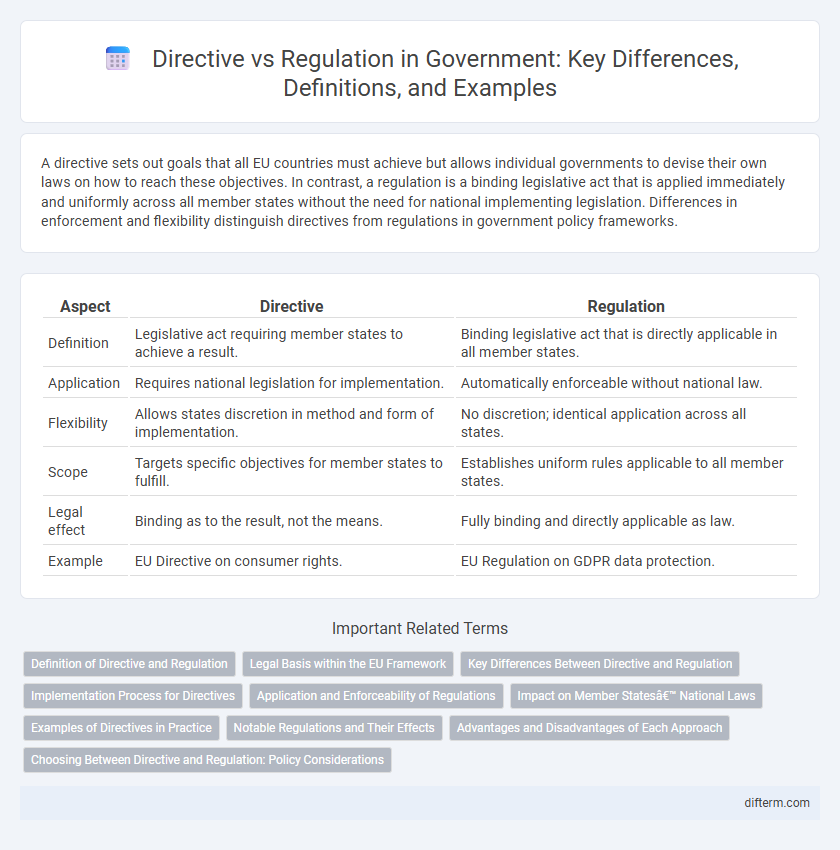A directive sets out goals that all EU countries must achieve but allows individual governments to devise their own laws on how to reach these objectives. In contrast, a regulation is a binding legislative act that is applied immediately and uniformly across all member states without the need for national implementing legislation. Differences in enforcement and flexibility distinguish directives from regulations in government policy frameworks.
Table of Comparison
| Aspect | Directive | Regulation |
|---|---|---|
| Definition | Legislative act requiring member states to achieve a result. | Binding legislative act that is directly applicable in all member states. |
| Application | Requires national legislation for implementation. | Automatically enforceable without national law. |
| Flexibility | Allows states discretion in method and form of implementation. | No discretion; identical application across all states. |
| Scope | Targets specific objectives for member states to fulfill. | Establishes uniform rules applicable to all member states. |
| Legal effect | Binding as to the result, not the means. | Fully binding and directly applicable as law. |
| Example | EU Directive on consumer rights. | EU Regulation on GDPR data protection. |
Definition of Directive and Regulation
A Directive is a legal act of the European Union that requires member states to achieve a particular result without dictating the means of achieving it, allowing national authorities flexibility in implementation. A Regulation is a binding legislative act that is directly applicable and enforceable in all member states without the need for national transposition. Directives set goals for member states, while regulations establish uniform laws that apply immediately and uniformly across the EU.
Legal Basis within the EU Framework
Regulations in the EU have direct legal effect, binding all member states immediately without the need for national implementation, ensuring uniform application across the bloc. Directives establish legal objectives that member states must achieve by adapting their own national laws within a specified timeframe, providing flexibility in form and method. The legal basis for both derives from the Treaty on the Functioning of the European Union (TFEU), which empowers the European Parliament and Council to enact these legislative instruments under distinct competencies.
Key Differences Between Directive and Regulation
Directives set binding goals that EU member states must achieve, allowing flexibility in national laws for implementation, whereas regulations are directly applicable and enforce uniform rules across all member states without the need for national legislation. Regulations ensure immediate legal effect and harmonization throughout the EU, while directives require transposition into domestic law within a specified timeframe. Key differences include the scope of application, legal immediacy, and the level of national discretion granted to member states.
Implementation Process for Directives
Directives require member states to transpose the provisions into national law within a specified deadline, allowing flexibility in how goals are achieved. The implementation process involves legislative, administrative, or judicial measures tailored by each country to align with national systems. This contrasts with regulations, which are directly applicable and enforceable without the need for national transposition.
Application and Enforceability of Regulations
Regulations have direct application and are immediately enforceable in all EU member states without the need for national legislation, ensuring uniformity and legal certainty. Directives require member states to achieve specific results, allowing flexibility in implementation through national laws, which can lead to varying enforcement across countries. The binding nature of regulations guarantees consistent compliance and streamlined governance within the EU legal framework.
Impact on Member States’ National Laws
Directives require Member States to achieve specific results while allowing flexibility in how they transpose the rules into national laws, leading to variations in implementation and timelines. Regulations have direct applicability and binding force across all Member States, eliminating the need for national transposition and ensuring uniform legal effects. This distinction significantly impacts the coherence and consistency of legal frameworks within the European Union.
Examples of Directives in Practice
Directives such as the EU Waste Framework Directive and the Services Directive exemplify how member states are required to achieve specific policy goals while retaining flexibility in implementation. The Data Protection Directive preceded the General Data Protection Regulation, setting baseline privacy standards across the EU. These examples demonstrate the role of directives in harmonizing legislation across jurisdictions without imposing uniform legal texts.
Notable Regulations and Their Effects
Notable regulations such as the General Data Protection Regulation (GDPR) have established comprehensive legal frameworks directly applicable across all EU member states, enhancing data privacy and consumer protection. Regulations create uniformity by imposing binding rules that require no national transposition, resulting in immediate legal impact and consistent enforcement. These effects streamline regulatory compliance, reduce administrative burdens, and strengthen the internal market's integrity and trust among citizens.
Advantages and Disadvantages of Each Approach
Directives offer flexibility by allowing member states to tailor implementation to their legal systems, promoting national sovereignty and adaptability; however, this can lead to inconsistent application and delays across jurisdictions. Regulations provide uniformity and immediate applicability throughout the entire union, ensuring equal standards and legal certainty, but they limit national discretion and may encounter resistance due to centralized enforcement. Choosing between directives and regulations involves balancing harmonization with respect for local legal traditions and administrative capacities.
Choosing Between Directive and Regulation: Policy Considerations
Regulations provide uniform rules directly applicable across all EU Member States, ensuring immediate legal effect and consistency in implementation. Directives offer flexibility, allowing national governments to adapt objectives within their legal systems, which can accommodate diverse legal traditions but may cause varied enforcement. Policymakers must assess the need for harmonization versus subsidiarity, administrative capacity, and the urgency of achieving policy goals when deciding between a directive or regulation.
Directive vs Regulation Infographic

 difterm.com
difterm.com